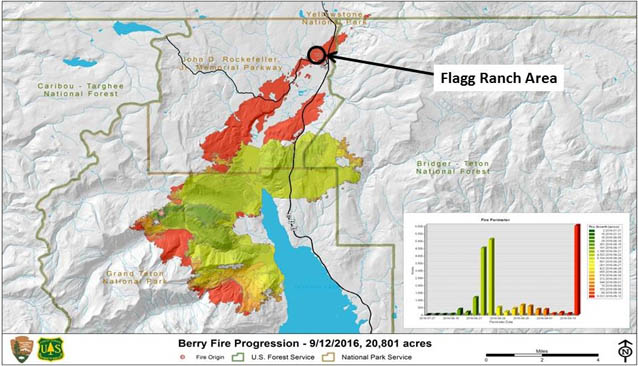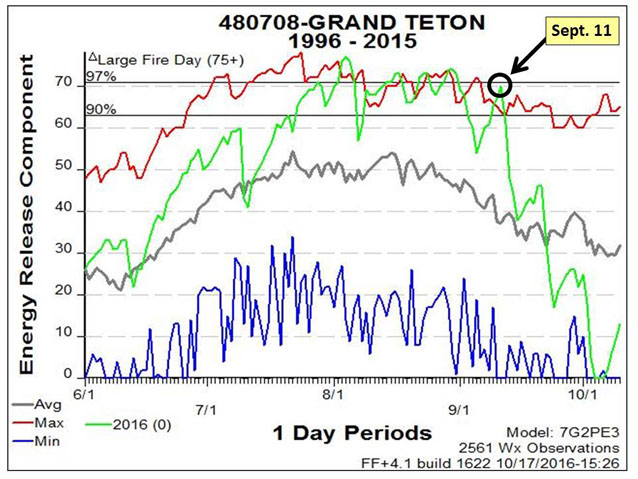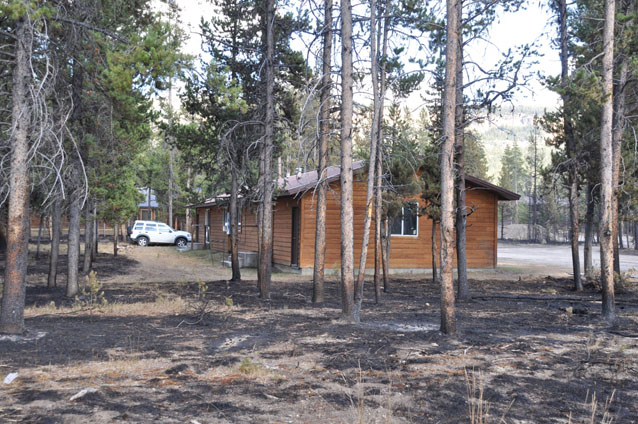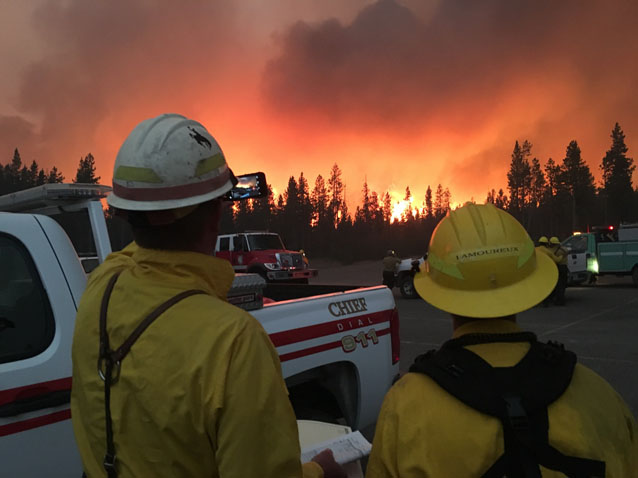
NPS
Mechanically treated areas and fire-adapted construction proved effective during the 2016 Berry Fire. On September 11, 2016 the Berry Fire made a wind-driven run in lodgepole pine/mixed conifer forest, covering six miles and reaching the Flagg Ranch developed area in the NPS John D. Rockefeller Parkway. Flagg Ranch is a remote community with a resort, campground, and employee residences, surrounded by wilderness. Thanks to several mechanical thinning projects, fire behavior moderated and dropped to the ground when it reached these previously treated areas. Firefighters set up sprinkler systems and pulled back until after the fire front passed. No structures were lost, likely due in large part to the use of fire-adapted construction materials. Many trees in the area are expected to survive.

NPS
Fire managers on the Berry Fire anticipated a low but realistic probability that under hot and dry conditions with high winds the fire had potential to reach Flagg Ranch. On August 22, the fire made a run across the north end of Jackson Lake and US Highway 89/191/287. At that time, Flagg Ranch was temporarily evacuated and structure protection was implemented by Great Basin Type II Fire Management Team 4. This included installing sprinkler systems and thinning along Grassy Lake Road. On September 30, Flagg residents were allowed to return to their homes but the Headwaters Resort remained closed.
When the Berry Fire began to threaten Flagg Ranch again on September 11, firefighters were ready and residents once again cleared out. Several engine crews were in place before the flames approached the developed area.

NPS

NPS
However planning for wildland fire at Flagg Ranch had truly began years earlier. Grand Teton National Park had treated 158 acres around the structures over the previous 15 years, providing a buffer of widely-spaced trees, reduced woody debris on the ground, and removal of ladder fuels. Treatment methods included limbing and felling trees with chain saws, and subsequently burning the slash in piles. Monitoring results for the treatments are summarized below.
Flagg Ranch Fuel Treatments

NPS

NPS
Flagg Ranch Fuel Treatment Time Series

NPS
What Happened on September 11?

NPS
As the Energy Release Component (ERC) graph below indicates, September 11 had record-setting fire conditions in 2016. This was combined with unusually high winds, averaging 18 mph and gusting to 30 mph.
When the Berry Fire made its wind-driven run toward Flagg Ranch, residents in the area were evacuated. Several interagency engines were dispatched to the area. They quickly turned on the network of sprinkler systems that had been previously set up around the structures.
As the torching fire behavior in the trees approached, a shower of burning embers landed on roofs, parking lots, and vegetation. In the areas where the forest had been treated, spot fires ignited and burned along the ground in short grasses. In untreated forest, lodgepole pines torched and sent more firebrands into the sky. Soon the firefighters pulled back to a safety zone due to the intense heat and smoke.
Once the flaming front had passed, firefighters moved back into the housing area and began mopping up. Thanks to metal roofs and well-maintained yards, no structures were burned. Some of the pine trees were scorched, but many were still green above the singed grasses. Much more severe crown fire effects occurred in untreated areas.

NPS
Why did Flagg Ranch survive the Berry Fire?

NPS
The Flagg Ranch developed area was successfully protected because it was ready for a fire. The structures themselves were fire resistant with metal roofs on most buildings. Yards were maintained with low grasses, and the lower branches of the trees were removed. Fire crews had time to implement structure protection in advance, and fire behavior was reduced. Flagg Ranch is an example of a Fire Adapted Community that not only weathered a crown fire in mixed conifer fuels, but did so while firefighters were staging in a safety zone.
What was learned after the Berry Fire spread through Flagg Ranch?

NPS
- Early activation of contingency resources allowed crews to become familiar with the area prior to the fire front passage.
- The crews saw the cleared treatment areas and this improved confidence in safety zones and re-engagement as the fire front passed through.
- Federal and county firefighters from Teton Interagency Fire and the local Type III incident management team had worked together in training. This assured good communications and smooth operations during the intense fire suppression response in the Flagg area.
- A community structure protection plan was written for Flagg Ranch that mapped the buildings and listed equipment needed. This plan proved very useful, but firefighters did not know it existed until they had already begun similar planning. Engine resources and fire management teams should have these tools in advance.
- In residential areas, screening is important. Where possible, the fuels thinning projects left somewhat denser trees and branches where it was safe to do so, such as on islands in the parking lots. After the Berry Fire these denser clumps of trees were all torched and killed.
- Firefighters who took suppression actions during the Berry Fire’s ember shower in the Flagg Ranch housing area credited metal roofs for the successful protection of the structures.
The National Cohesive Wildland Fire Management Strategy
The management of the Berry Fire and the survival of Flagg Ranch serve to highlight the three goals of the Cohesive Strategy. Because Grand Teton National Park’s managers were confident that the remote Flagg Ranch community was fire adapted, they were able to allow the lightning-ignited Berry Fire to play its natural role in strengthening the resilience of the fire-adapted landscape. The suppression response to the Berry Fire was based on risk assessments and grounded in safety for firefighters, visitors, and developed areas. Flagg Ranch was a fire adapted community because of fuels treatments, structure protection plans, and appropriate building materials.
Last updated: December 14, 2017
